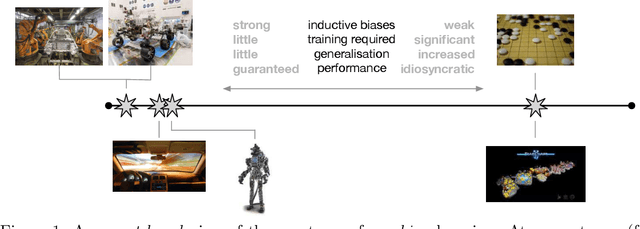Michiel Van de Panne
From Machine Learning to Robotics: Challenges and Opportunities for Embodied Intelligence
Oct 28, 2021
Abstract:Machine learning has long since become a keystone technology, accelerating science and applications in a broad range of domains. Consequently, the notion of applying learning methods to a particular problem set has become an established and valuable modus operandi to advance a particular field. In this article we argue that such an approach does not straightforwardly extended to robotics -- or to embodied intelligence more generally: systems which engage in a purposeful exchange of energy and information with a physical environment. In particular, the purview of embodied intelligent agents extends significantly beyond the typical considerations of main-stream machine learning approaches, which typically (i) do not consider operation under conditions significantly different from those encountered during training; (ii) do not consider the often substantial, long-lasting and potentially safety-critical nature of interactions during learning and deployment; (iii) do not require ready adaptation to novel tasks while at the same time (iv) effectively and efficiently curating and extending their models of the world through targeted and deliberate actions. In reality, therefore, these limitations result in learning-based systems which suffer from many of the same operational shortcomings as more traditional, engineering-based approaches when deployed on a robot outside a well defined, and often narrow operating envelope. Contrary to viewing embodied intelligence as another application domain for machine learning, here we argue that it is in fact a key driver for the advancement of machine learning technology. In this article our goal is to highlight challenges and opportunities that are specific to embodied intelligence and to propose research directions which may significantly advance the state-of-the-art in robot learning.
Progressive Reinforcement Learning with Distillation for Multi-Skilled Motion Control
Feb 13, 2018



Abstract:Deep reinforcement learning has demonstrated increasing capabilities for continuous control problems, including agents that can move with skill and agility through their environment. An open problem in this setting is that of developing good strategies for integrating or merging policies for multiple skills, where each individual skill is a specialist in a specific skill and its associated state distribution. We extend policy distillation methods to the continuous action setting and leverage this technique to combine expert policies, as evaluated in the domain of simulated bipedal locomotion across different classes of terrain. We also introduce an input injection method for augmenting an existing policy network to exploit new input features. Lastly, our method uses transfer learning to assist in the efficient acquisition of new skills. The combination of these methods allows a policy to be incrementally augmented with new skills. We compare our progressive learning and integration via distillation (PLAID) method against three alternative baselines.
 Add to Chrome
Add to Chrome Add to Firefox
Add to Firefox Add to Edge
Add to Edge